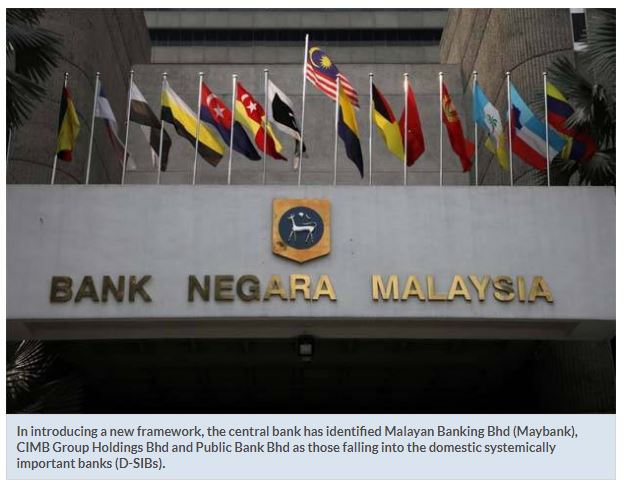Malaysia’s top 3 banks need to maintain higher than normal capital needs
PETALING JAYA: Malaysia’s top three banks would need to maintain higher than normal capital requirements in order to mitigate risks to the overall banking system, said Bank Negara.
In introducing a new framework, the central bank has identified MALAYAN BANKING BHD (Maybank), CIMB GROUP HOLDINGS BHD
(Maybank), CIMB GROUP HOLDINGS BHD and PUBLIC BANK BHD
and PUBLIC BANK BHD as those falling into the domestic systemically important banks (D-SIBs).
as those falling into the domestic systemically important banks (D-SIBs).
Under this framework, the three biggest banks in Malaysia by asset size would need to maintain higher capital buffers to meet regulatory capital requirements that include a higher loss absorbency (HLA) requirement.
Bank Negara said D-SIBs referred to banks whose distress or failure have the potential to cause considerable disruption to the domestic financial system and the wider economy.
“Higher capital requirements introduced for such banks will complement the regulatory framework in place to mitigate the risks posed by D-SIBs to the stability of the Malaysian financial system and the wider economy, ” it said in a statement.
It said Maybank, CIMB and Public Bank were idenified as D-SIBs based on 2018 data and the assessment methodology set out in the policy document.
“In accordance with the framework, the applicable HLA requirement for these DSIBs ranges between 0.5% to 1.0% of risk-weighted assets, at the consolidated level. The HLA requirement for these D-SIBs will come into effect on Jan 31,2021, ” it said.
Going forward, the list of D-SIBs will be updated annually and published together with the release of the Bank’s Financial Stability Review in the second half of each year.
“D-SIBs are identified based on an indicator-based measurement approach (IBA). The IBA uses indicators across three categories – size, interconnectedness and substitutability to determine the degree of a banking institution’s systemic importance, ” the central bank said.
It said the assessment is also supplemented by the supervisory overlay process, which incorporated information that may not be easily quantified or fully captured by the IBA.
Bank Negara said banks in the Malaysian banking system are generally well capitalised and have sufficient buffers to withstand potential losses even under adverse economic and financial conditions.
“The central bank expects the designated D-SIBs to be able to meet the additional capital buffer requirement, which comes into effect on Jan 31,2021, without having to raise additional capital and with minimal impact to their business activities, ” it said.
In the policy document, Bank Negara said it may, at its discretion, impose additional requirements and policy measures as deemed appropriate to manage risks posed by D-SIBs.
In its document, Bank Negara explained the rationale of introducing this new framework, highlighting that the 2008 global financial crisis had exposed the “too big to fail” problem with large banks.
It noted that “too-big-to-fail” issue with banks existed not only at the global level but also national level in Malaysia.
“The distress and failure of large financial institutions created enormous stress in the financial system and harmed the real economy, thereby exposing the ‘too-big-to-fail’ problem, ” the central bank said.
“Broadly, the ‘too-big-to-fail’ problem refers to the situation whereby a financial institution is considered either too large, complex and/or highly interconnected with other parts of the financial system and economy such that its distress or disorderly failure could cause significant disruption to the functioning of the financial system and economy. Such financial institutions are also known as systemically important financial institutions, ” it added.
Bank Negara said that in the aftermath of the crisis, a comprehensive set of policies were devised by global standard setting bodies to address the “too-big-to-fail” problem, one of which is to develop a framework to identify systemically important banks (SIBs) and to increase resilience of SIBs to distress events.
“At the global level, the Financial Stability Board identifies SIBs, also known as global SIBs (G-SIBs). There are currently 30 G-SIBs that provides a wide range of financial services across many countries, including in Malaysia.
“G-SIBs are required to hold additional capital buffers and are subject to higher supervisory expectations in the areas of risk management, governance and internal controls, ” Bank Negara added.
Source: https://www.thestar.com.my/business/business-news/2020/02/06/malaysia039s-top-3-banks-need-to-maintain-higher-than-normal-capital-needs


 English
English




